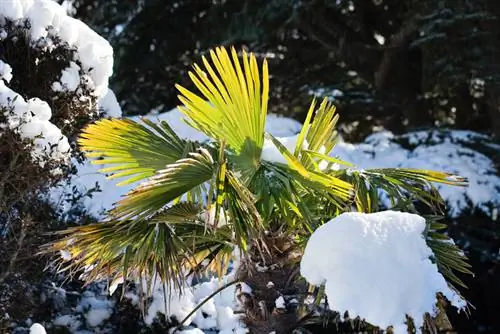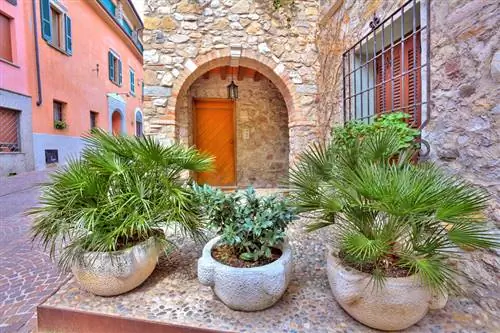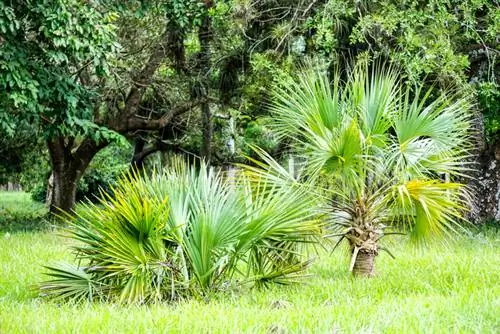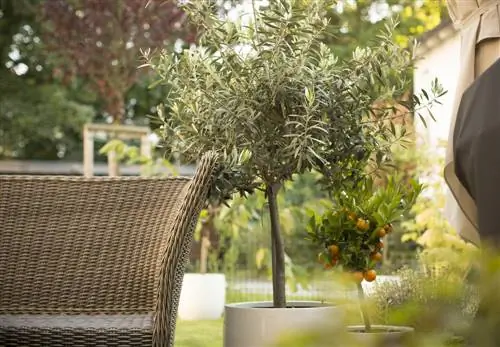- Author admin [email protected].
- Public 2023-12-16 16:46.
- Last modified 2025-01-23 11:20.
When people think of palm trees, they only imagine Mediterranean beaches or oases, areas where a mild climate prevails all year round. However, palm trees are extremely versatile and thrive not only in tropical swamps, rainforests or deserts, but even in cool mountain forests and at altitudes of over 2000 meters. Here the attractive plants have to survive snow and low temperatures and have adapted excellently to these harsh climatic conditions.
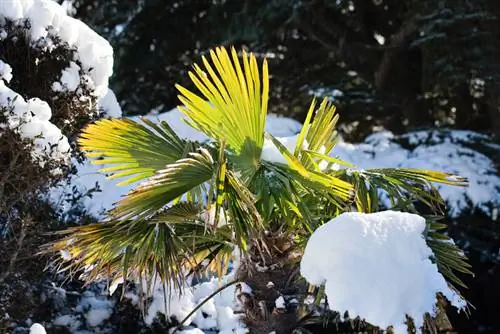
Which palm trees are hardy and suitable for the garden?
Hardy palm species that are suitable for gardens in cooler regions include hemp palm, needle palm, dwarf palmetto and honey palm. These palm trees can tolerate sub-zero temperatures and can overwinter outdoors with appropriate protection.
Frost-hardy palm trees, also something for our gardens?
Numerous examples show that year-round outdoor cultivation of palm trees works very well in our latitudes. At least if you only choose species that are sufficiently winter-hardy, care is not as time-consuming as expected. Feel free to give it a try, with our care instructions nothing can go wrong.
Suitable varieties
The most commonly found in our green spaces are:
- Hemp palm
- Needle Palm
- Dwarf Palmetto
- Honey palm
There are also other types of palm trees that are quite winter-proof. Which sub-zero temperatures the plant can withstand is usually noted on the plant label.
If you want to plant the palm directly, you should not purchase a very small specimen from a specialist retailer. The plants grow quite slowly and plants under 50 centimeters are still too delicate to remain in the garden all year round.
Alternatively, you can care for a small or home-grown potted plant on the balcony or terrace for the first few years and overwinter in the house. Once the palm tree has reached the required size, you can place the beauty in its final place.
Get used to the outdoors carefully
Palm trees are no different than us after the long winter months: If you suddenly move them from your room directly into the blazing sun and leave them outside all day, this would severely damage the plants. There is a risk of sunburn and frost damage caused by late night frosts. Therefore, give the palm tree some time to acclimatize.
It has proven to be a good idea to initially place the plants in a protected place on the balcony or terrace, where they are only exposed to the morning or evening sun for a few hours. If there is a threat of frost, spread a plant fleece loosely over the palm tree or bring it back into the house for a short time.
After one to two weeks, move the palm tree and the pot to its final place in the garden. Only when she has completely adjusted here after a few days will she be used.
Which location is suitable?
Even a winter-proof palm tree needs one if possible
- warm
- sunny
- sheltered from the wind
- not too wet
Location. This can be achieved relatively easily in the home garden.
Sufficient warmth and sun
Choose a spot near a south-facing wall of the house. Here the sun reaches the plant for a few hours even in the winter months. It can never be too sunny for the palm tree, where summer heat affects other plants, so it feels absolutely comfortable. Another advantage: The wall surface stores heat even in the cold season and radiates it at night, so that the ambient temperature is always a few degrees higher.
Protection from wind
Gusts of wind ruffle the attractive fronds and can break them, which looks unsightly and can damage the plant. In addition, it is always a little cooler in windy locations, which the heat-loving sun worshiper doesn't like at all.
Not too wet
Of course, palm trees also need enough water, but they don't like a place with waterlogging. Well-drained soil is ideal. An optional drainage layer in the planting hole ensures optimal water drainage.
Even hardy palm trees need protection from frost
How winter-proof the palm tree you planted is depends on two factors:
- The palm species
- The age of the plant.
- The duration of the frost period.
A single day on which the temperature falls below the level that the planted variety can withstand usually does not harm the palm tree. However, if the thermometer falls over a longer period of time, even a palm tree that has been declared winter-proof needs sufficient winter protection.
In very mild regions it is often sufficient to loosely tie the leaves together and spread a thick layer of mulch in the root area. Additionally, you can wrap the plant with a straw mat or a jute sack.
In rougher locations, we recommend a temporary greenhouse (€8.00 on Amazon), which you can build yourself or purchase ready-made from a specialist retailer. Slatted struts that are covered with fleece or special plant film can be made on your own inexpensively and with relatively little effort. No matter which variant you choose, ensure regular ventilation whenever you close your winter shelter to prevent fungal infestation.
Tip
A blanket of snow has an insulating effect and does not harm the hardy palm trees. However, snow is also quite heavy and bends the fronds. Therefore, when it snows, shake off the white splendor from the fronds or the fleece surrounding them.

